计算机网络安全与防范外文翻译文献
- 格式:doc
- 大小:78.81 KB
- 文档页数:18
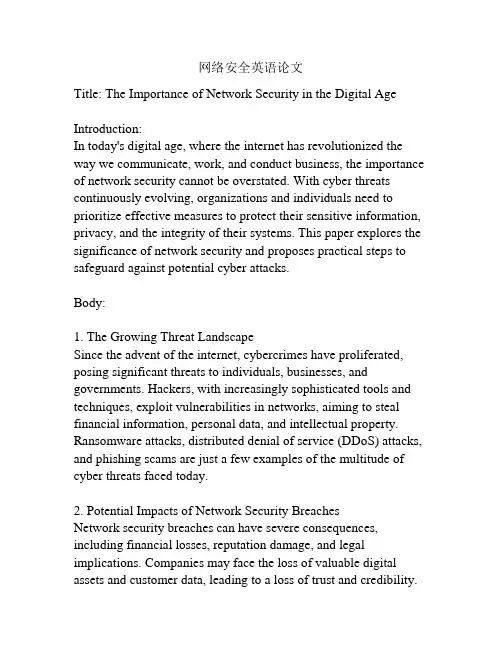
网络安全英语论文Title: The Importance of Network Security in the Digital Age Introduction:In today's digital age, where the internet has revolutionized the way we communicate, work, and conduct business, the importance of network security cannot be overstated. With cyber threats continuously evolving, organizations and individuals need to prioritize effective measures to protect their sensitive information, privacy, and the integrity of their systems. This paper explores the significance of network security and proposes practical steps to safeguard against potential cyber attacks.Body:1. The Growing Threat LandscapeSince the advent of the internet, cybercrimes have proliferated, posing significant threats to individuals, businesses, and governments. Hackers, with increasingly sophisticated tools and techniques, exploit vulnerabilities in networks, aiming to steal financial information, personal data, and intellectual property. Ransomware attacks, distributed denial of service (DDoS) attacks, and phishing scams are just a few examples of the multitude of cyber threats faced today.2. Potential Impacts of Network Security BreachesNetwork security breaches can have severe consequences, including financial losses, reputation damage, and legal implications. Companies may face the loss of valuable digital assets and customer data, leading to a loss of trust and credibility.Moreover, breaches in critical infrastructure systems, such as power grids and healthcare systems, can result in devastating consequences for society as a whole. Therefore, prioritizing robust network security measures is imperative to mitigate potential damages.3. Network Security MeasuresTo combat cyber threats effectively, organizations and individuals should implement a multi-layered approach to network security. This includes:a) Firewalls: Deploying firewalls acts as the first line of defense against unauthorized access, ensuring that only legitimate traffic is allowed into a network.b) Encryption: Encrypting data in transit and at rest helps to protect sensitive information from unauthorized access, ensuring that even if a breach occurs, the data remains unreadable.c) Strong Passwords and Two-factor Authentication: Encouraging the use of complex passwords and implementing two-factor authentication adds an extra layer of security, making it harder for attackers to gain access to sensitive accounts.d) Regular Software Updates and Patches: Keeping software, operating systems, and applications up to date helps to address any known vulnerabilities and weaknesses, mitigating the risk of exploitation.e) Employee Education and Awareness: Establishingcomprehensive training programs to educate employees about cybersecurity threats, such as phishing and social engineering, helps to build a strong human firewall and foster a security-conscious culture within an organization.4. Collaboration and Government InvolvementGiven the global nature of cyber threats, collaboration between governments, organizations, and individuals is crucial to combating cybercrimes effectively. Governments should enact strong legislation and regulations to protect individuals' privacy and organizations' sensitive information. Additionally, international cooperation is essential to sharing information about emerging threats, best practices, and conducting joint investigations.Conclusion:In conclusion, network security is a critical aspect of our digital lives and is paramount in protecting individuals, organizations, and critical infrastructure from cyber threats. Implementing robust network security measures, such as firewalls, encryption, and regular updates, along with fostering a culture of cybersecurity awareness, is key to safeguarding against potential attacks. It is imperative that governments, organizations, and individuals work together to address this ever-evolving threat landscape and ensure a secure and resilient digital environment.。
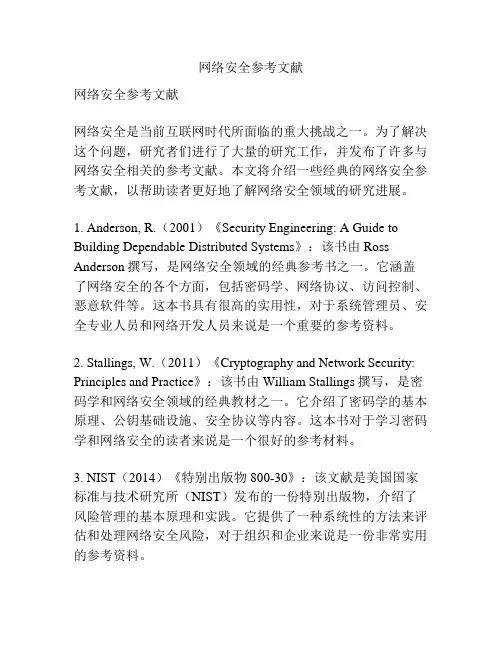
网络安全参考文献网络安全参考文献网络安全是当前互联网时代所面临的重大挑战之一。
为了解决这个问题,研究者们进行了大量的研究工作,并发布了许多与网络安全相关的参考文献。
本文将介绍一些经典的网络安全参考文献,以帮助读者更好地了解网络安全领域的研究进展。
1. Anderson, R.(2001)《Security Engineering: A Guide to Building Dependable Distributed Systems》:该书由Ross Anderson撰写,是网络安全领域的经典参考书之一。
它涵盖了网络安全的各个方面,包括密码学、网络协议、访问控制、恶意软件等。
这本书具有很高的实用性,对于系统管理员、安全专业人员和网络开发人员来说是一个重要的参考资料。
2. Stallings, W.(2011)《Cryptography and Network Security: Principles and Practice》:该书由William Stallings撰写,是密码学和网络安全领域的经典教材之一。
它介绍了密码学的基本原理、公钥基础设施、安全协议等内容。
这本书对于学习密码学和网络安全的读者来说是一个很好的参考材料。
3. NIST(2014)《特别出版物800-30》:该文献是美国国家标准与技术研究所(NIST)发布的一份特别出版物,介绍了风险管理的基本原理和实践。
它提供了一种系统性的方法来评估和处理网络安全风险,对于组织和企业来说是一份非常实用的参考资料。
4. Pfleeger, C.P. and Pfleeger, S.L.(2002)《Security in Computing》:该书由Charles P. Pfleeger和Shari Lawrence Pfleeger撰写,涵盖了计算机安全的各个方面。
它介绍了安全策略制定、脆弱性分析、防御机制等内容,对于计算机安全的初学者和从业者来说是一本非常有价值的参考书。
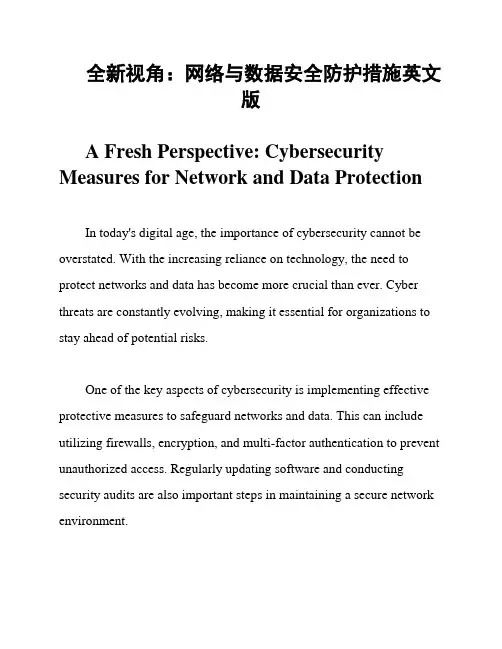
全新视角:网络与数据安全防护措施英文版
A Fresh Perspective: Cybersecurity Measures for Network and Data Protection
In today's digital age, the importance of cybersecurity cannot be overstated. With the increasing reliance on technology, the need to protect networks and data has become more crucial than ever. Cyber threats are constantly evolving, making it essential for organizations to stay ahead of potential risks.
One of the key aspects of cybersecurity is implementing effective protective measures to safeguard networks and data. This can include utilizing firewalls, encryption, and multi-factor authentication to prevent unauthorized access. Regularly updating software and conducting security audits are also important steps in maintaining a secure network environment. Furthermore, employee training and awareness play a significant role in cybersecurity. Educating staff on best practices for handling sensitive information and recognizing phishing attempts can help prevent security breaches. Implementing strong password policies and enforcing data encryption can also enhance overall security measures.
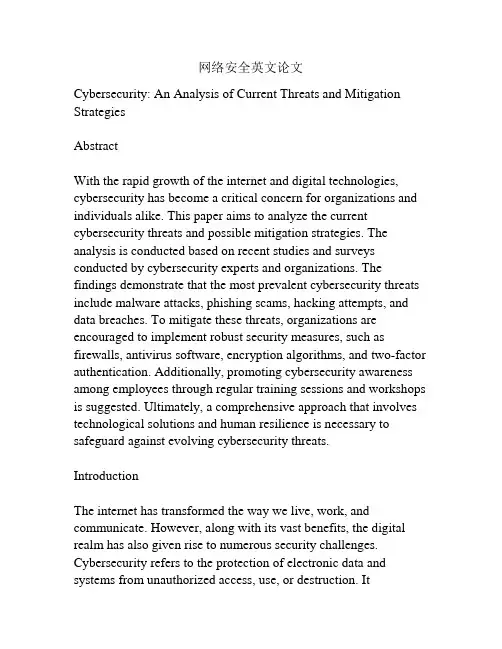
网络安全英文论文Cybersecurity: An Analysis of Current Threats and Mitigation StrategiesAbstractWith the rapid growth of the internet and digital technologies, cybersecurity has become a critical concern for organizations and individuals alike. This paper aims to analyze the current cybersecurity threats and possible mitigation strategies. The analysis is conducted based on recent studies and surveys conducted by cybersecurity experts and organizations. The findings demonstrate that the most prevalent cybersecurity threats include malware attacks, phishing scams, hacking attempts, and data breaches. To mitigate these threats, organizations are encouraged to implement robust security measures, such as firewalls, antivirus software, encryption algorithms, and two-factor authentication. Additionally, promoting cybersecurity awareness among employees through regular training sessions and workshops is suggested. Ultimately, a comprehensive approach that involves technological solutions and human resilience is necessary to safeguard against evolving cybersecurity threats.IntroductionThe internet has transformed the way we live, work, and communicate. However, along with its vast benefits, the digital realm has also given rise to numerous security challenges. Cybersecurity refers to the protection of electronic data and systems from unauthorized access, use, or destruction. Itencompasses a wide range of threats, such as hacking, data breaches, viruses, and phishing scams. The consequences of a cybersecurity breach can be severe, including financial losses, compromised sensitive information, and damage to reputation.Current Cybersecurity Threats1. Malware Attacks: Malware, short for malicious software, includes viruses, worms, Trojan horses, and ransomware. Malware can infect systems through email attachments, downloads, or vulnerabilities in software. Once installed, it can grant unauthorized access to hackers and cause significant damage, such as stealing sensitive data, corrupting files, or encrypting data for ransom.2. Phishing Scams: Phishing is a fraudulent activity where attackers impersonate legitimate organizations through emails, text messages, or phone calls to deceive individuals into revealing sensitive information, such as passwords, credit card details, or social security numbers. Successful phishing attacks can lead to identity theft or unauthorized access to personal accounts.3. Hacking Attempts: Hackers use various techniques to exploit vulnerabilities in computer systems, networks, or software. They may employ password cracking, SQL injection, or distributed denial-of-service (DDoS) attacks to gain unauthorized access, manipulate data, or disrupt services. Hacking attempts can result in data breaches, financial losses, or damage to critical infrastructure.4. Data Breaches: Data breaches involve the unauthorized access,theft, or exposure of sensitive information held by organizations. Personal, financial, or healthcare data can be compromised and misused for identity theft, fraud, or blackmail. Data breaches can occur due to inadequate security measures, insider threats, or hacking activities.Mitigation Strategies1. Robust Security Measures: Organizations should implement a multi-layered security approach, including firewalls, intrusion detection systems, and antivirus software. Regular updates to software and patches should be applied to address vulnerabilities and protect against known threats. Additionally, encryption algorithms can ensure the confidentiality of data both in transit and at rest.2. Two-Factor Authentication: Enforcing two-factor authentication adds an extra layer of security by requiring users to provide two forms of identification, such as a password and a unique verification code. This method significantly reduces the risk of unauthorized access, even if passwords are compromised.3. Employee Training and Awareness: Organizations should conduct regular cybersecurity training sessions to educate employees about potential threats and safe online practices. This includes educating them about phishing scams, malware, and the importance of strong passwords. By enhancing employee awareness, organizations can develop a stronger line of defense against social engineering attacks.ConclusionAs the digital landscape continues to evolve, so do the cybersecurity threats. Organizations and individuals must remain vigilant to protect their sensitive information and digital assets. By implementing robust security measures, promoting cybersecurity awareness, and staying updated on the latest threats and mitigation strategies, individuals and organizations can mitigate the risks associated with cyber threats. Through a comprehensive approach that combines technological solutions and human resilience, a safer digital future can be achieved.References:[Insert references here]。
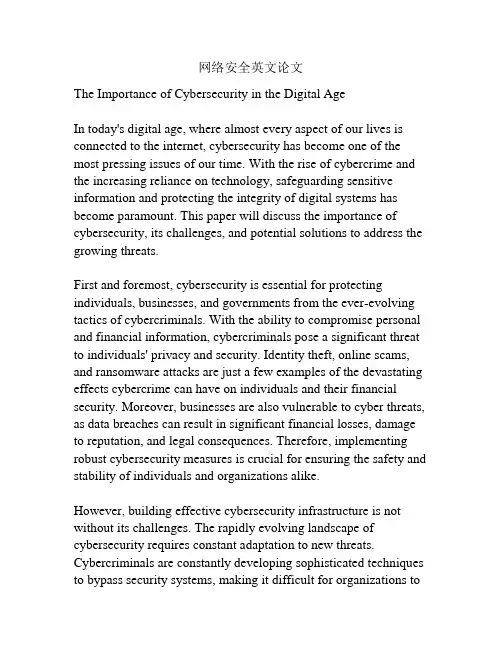
网络安全英文论文The Importance of Cybersecurity in the Digital AgeIn today's digital age, where almost every aspect of our lives is connected to the internet, cybersecurity has become one of the most pressing issues of our time. With the rise of cybercrime and the increasing reliance on technology, safeguarding sensitive information and protecting the integrity of digital systems has become paramount. This paper will discuss the importance of cybersecurity, its challenges, and potential solutions to address the growing threats.First and foremost, cybersecurity is essential for protecting individuals, businesses, and governments from the ever-evolving tactics of cybercriminals. With the ability to compromise personal and financial information, cybercriminals pose a significant threat to individuals' privacy and security. Identity theft, online scams, and ransomware attacks are just a few examples of the devastating effects cybercrime can have on individuals and their financial security. Moreover, businesses are also vulnerable to cyber threats, as data breaches can result in significant financial losses, damage to reputation, and legal consequences. Therefore, implementing robust cybersecurity measures is crucial for ensuring the safety and stability of individuals and organizations alike.However, building effective cybersecurity infrastructure is not without its challenges. The rapidly evolving landscape of cybersecurity requires constant adaptation to new threats. Cybercriminals are constantly developing sophisticated techniques to bypass security systems, making it difficult for organizations tostay ahead. Furthermore, the shortage of skilled cybersecurity professionals poses a significant challenge in creating and maintaining resilient cybersecurity strategies. The demand for cybersecurity experts is projected to exceed the supply, creating a gap that needs to be adequately addressed. Additionally, the lack of cybersecurity awareness among individuals also contributes to the vulnerability of systems. Education and training programs need to be implemented to enhance the general understanding of cybersecurity and its importance.To address these challenges, a multi-pronged approach to cybersecurity is required. Firstly, collaboration between governments, businesses, and individuals is crucial for combating cyber threats effectively. Information sharing and cooperation can help identify vulnerabilities and develop proactive measures to mitigate potential risks. Secondly, investing in research and development is essential for staying ahead of cybercriminals. By continuously improving security technologies and tools, organizations can better protect their assets and data. Moreover, fostering cybersecurity education and awareness at all levels is crucial for creating a culture of cyber hygiene. This includes training employees to identify and respond to potential threats and promoting responsible online behavior among individuals.In conclusion, the importance of cybersecurity in today's digital age cannot be overstated. With the ever-increasing reliance on technology, individuals, businesses, and governments must prioritize the protection of sensitive information from cybercrime. While there are challenges to overcome, through collaboration, investment in research and development, and the promotion ofcybersecurity education, it is possible to create a secure digital ecosystem. Only by working together can we ensure the safety and privacy of our digital world.。
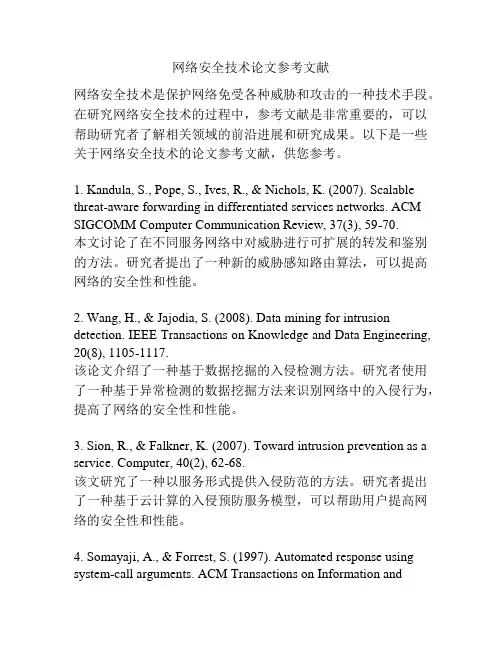
网络安全技术论文参考文献网络安全技术是保护网络免受各种威胁和攻击的一种技术手段。
在研究网络安全技术的过程中,参考文献是非常重要的,可以帮助研究者了解相关领域的前沿进展和研究成果。
以下是一些关于网络安全技术的论文参考文献,供您参考。
1. Kandula, S., Pope, S., Ives, R., & Nichols, K. (2007). Scalable threat-aware forwarding in differentiated services networks. ACM SIGCOMM Computer Communication Review, 37(3), 59-70.本文讨论了在不同服务网络中对威胁进行可扩展的转发和鉴别的方法。
研究者提出了一种新的威胁感知路由算法,可以提高网络的安全性和性能。
2. Wang, H., & Jajodia, S. (2008). Data mining for intrusion detection. IEEE Transactions on Knowledge and Data Engineering, 20(8), 1105-1117.该论文介绍了一种基于数据挖掘的入侵检测方法。
研究者使用了一种基于异常检测的数据挖掘方法来识别网络中的入侵行为,提高了网络的安全性和性能。
3. Sion, R., & Falkner, K. (2007). Toward intrusion prevention as a service. Computer, 40(2), 62-68.该文研究了一种以服务形式提供入侵防范的方法。
研究者提出了一种基于云计算的入侵预防服务模型,可以帮助用户提高网络的安全性和性能。
4. Somayaji, A., & Forrest, S. (1997). Automated response using system-call arguments. ACM Transactions on Information andSystem Security (TISSEC), 1(4), 262-288.该论文介绍了一种基于系统调用参数的自动响应方法。
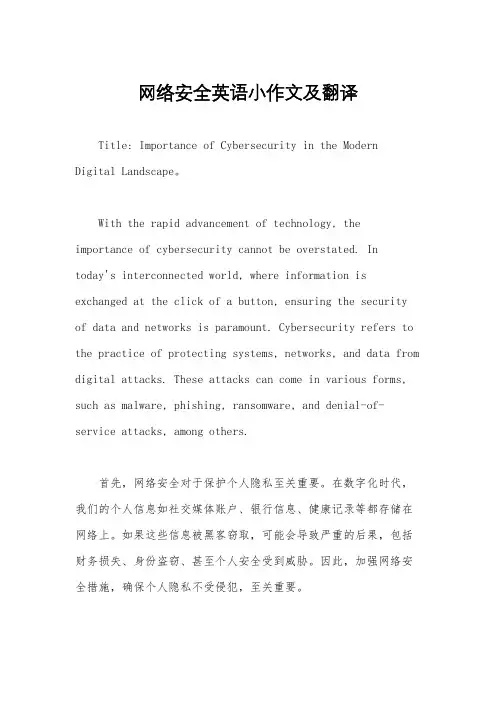
网络安全英语小作文及翻译Title: Importance of Cybersecurity in the ModernDigital Landscape。
With the rapid advancement of technology, the importance of cybersecurity cannot be overstated. Intoday's interconnected world, where information is exchanged at the click of a button, ensuring the security of data and networks is paramount. Cybersecurity refers to the practice of protecting systems, networks, and data from digital attacks. These attacks can come in various forms, such as malware, phishing, ransomware, and denial-of-service attacks, among others.首先,网络安全对于保护个人隐私至关重要。
在数字化时代,我们的个人信息如社交媒体账户、银行信息、健康记录等都存储在网络上。
如果这些信息被黑客窃取,可能会导致严重的后果,包括财务损失、身份盗窃、甚至个人安全受到威胁。
因此,加强网络安全措施,确保个人隐私不受侵犯,至关重要。
Secondly, cybersecurity is crucial for safeguarding businesses and organizations. In today's digital economy, companies rely heavily on digital systems to storesensitive information, conduct transactions, and communicate with clients and partners. A cyber-attack on a business can result in financial losses, damage to reputation, and even legal consequences. Therefore, investing in robust cybersecurity measures is essential for protecting intellectual property, trade secrets, and the overall integrity of the organization.Thirdly, cybersecurity plays a vital role in national security. Governments around the world store vast amounts of sensitive information, including classified documents, infrastructure plans, and military strategies, on digital systems. A breach of these systems can compromise not only national security but also the safety of citizens. Additionally, cyber-attacks can be used as a tool for espionage, sabotage, and warfare between nations. Thus, ensuring the cybersecurity of government networks iscrucial for protecting the interests of the state and maintaining geopolitical stability.In conclusion, cybersecurity is essential in the modern digital landscape to protect personal privacy, secure businesses and organizations, and safeguard national security. It requires a comprehensive approach involving technology, policies, and awareness among users. By investing in robust cybersecurity measures and staying vigilant against emerging threats, we can mitigate therisks posed by cyber-attacks and build a safer and more secure digital world.。
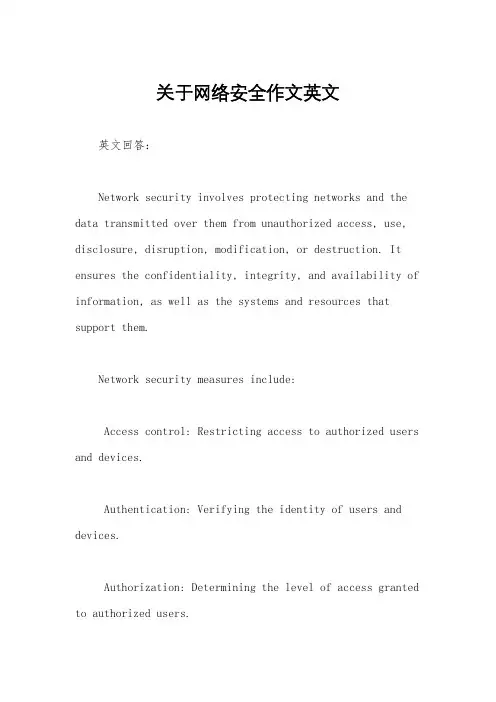
关于网络安全作文英文英文回答:Network security involves protecting networks and the data transmitted over them from unauthorized access, use, disclosure, disruption, modification, or destruction. It ensures the confidentiality, integrity, and availability of information, as well as the systems and resources that support them.Network security measures include:Access control: Restricting access to authorized users and devices.Authentication: Verifying the identity of users and devices.Authorization: Determining the level of access granted to authorized users.Data encryption: Protecting data from unauthorized access.Intrusion detection and prevention: Monitoring networks for suspicious activity and preventing attacks.Firewall: Blocking unauthorized access to networks.Network segmentation: Dividing networks into smaller, isolated segments to limit the spread of threats.Patch management: Updating software and systems to address vulnerabilities.Security awareness training: Educating users on network security best practices.中文回答:网络安全涉及保护网络和通过网络传输的数据,使其免遭未经授权的访问、使用、披露、破坏、修改或销毁。
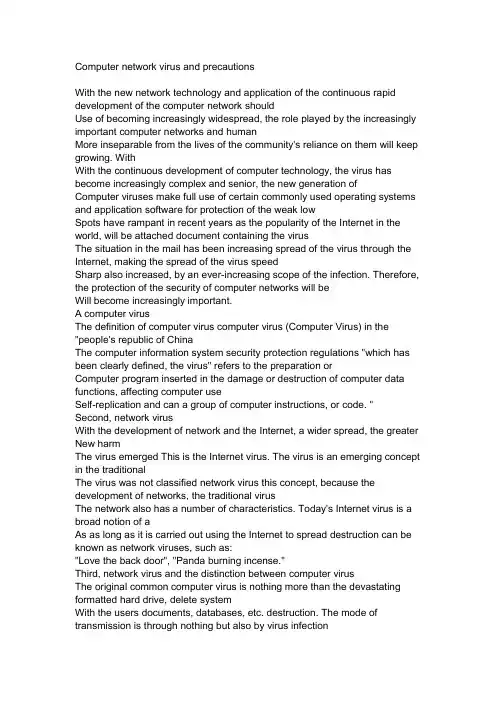
Computer network virus and precautionsWith the new network technology and application of the continuous rapid development of the computer network shouldUse of becoming increasingly widespread, the role played by the increasingly important computer networks and humanMore inseparable from the lives of the community's reliance on them will keep growing. WithWith the continuous development of computer technology, the virus has become increasingly complex and senior, the new generation ofComputer viruses make full use of certain commonly used operating systems and application software for protection of the weak lowSpots have rampant in recent years as the popularity of the Internet in the world, will be attached document containing the virusThe situation in the mail has been increasing spread of the virus through the Internet, making the spread of the virus speedSharp also increased, by an ever-increasing scope of the infection. Therefore, the protection of the security of computer networks will beWill become increasingly important.A computer virusThe definition of computer virus computer virus (Computer Virus) in the "people's republic of ChinaThe computer information system security protection regulations "which has been clearly defined, the virus" refers to the preparation orComputer program inserted in the damage or destruction of computer data functions, affecting computer useSelf-replication and can a group of computer instructions, or code. " Second, network virusWith the development of network and the Internet, a wider spread, the greater New harmThe virus emerged This is the Internet virus. The virus is an emerging concept in the traditionalThe virus was not classified network virus this concept, because the development of networks, the traditional virusThe network also has a number of characteristics. Today's Internet virus is a broad notion of aAs as long as it is carried out using the Internet to spread destruction can be known as network viruses, such as:"Love the back door", "Panda burning incense."Third, network virus and the distinction between computer virusThe original common computer virus is nothing more than the devastating formatted hard drive, delete systemWith the users documents, databases, etc. destruction. The mode of transmission is through nothing but also by virus infectionMutual copy of the software, carrying the virus, such as the use of pirated optical discs, such as infection disk systemsThe pilot virus and infected executable file virus, in addition to a network virus These are the common characteristics of the virus, but also steal users with remote data, remote control of the other sideComputers and other damaged properties, such as Trojan and consumption of funding the operation of the network computerSource collapse of the network server worm.Fourth, the network against virusNetwork destructive virus, will directly affect the work of the network, ranging from lowering speed videoRing for the efficiency of the network, while in the collapse, undermining the server information to a multi-year work destroyedDan. Because viruses and other network annually fraud led to economic losses of over 16 billion yuan,But this figure is constantly rising year by year. The next few years, the size of the market will reach Security60 billion yuan. One antivirus software experts pointed out: "Network avian flu virus even more." Such as: "XiongCat burning incense "In addition to virus infection through the web site users, the latest virus also through QQLoopholes in propagating itself through file-sharing networks, the default sharing, weak password systems, U disk and windowsForms bottom of the top mobile hard drives, and other means of communication. While LAN once a computer machineFor infection, it can spread through the entire network instant, or even within a very short period of time can be infectedThousands of computers, can lead to serious networks. Symptoms of poisoning in the performance of computersThere are enforceable. Exe files have become a strange pattern, the pattern shown as "PandaBurning incense, "and then System blue screen, restart the frequent, hard drive data destruction, serious entire companyAll computer LAN will all poisoning. "Panda burning incense," only more than half a month, a few varieties have highOf more than 50, and the number of its users infected constantly expanding. Makes infected, "Panda burn incense" diseaseThe personal drug users has been as high as several million people infected with a few more corporate users is rising exponentially. NetworkMore on the computer network the greater the harm caused by the virus.V. network transmission of the virus Features1. Infection fast: single machine environment, the virus can only be passed from one computer disketteTo another, and in the network can be adopted by the rapid spread of network communication mechanism. According to measurementSet against a typical PC network use in normal circumstances, once a computer workstation sickDrugs, and will be online within 10 minutes in the several hundreds of all infected computers.2. Proliferation of a wide range: in the network due to the spread of the virus very quickly and spread to encompass a large area, not only the rapid transmission of all LAN computer, but also through remote workstations virus in一瞬Inter spread to thousands of miles away.3. Dissemination in the form of complex and varied: computer viruses in general through the network "Station server workstation "channels of communication, but in the form of complex and diverse communication.4. Difficult to completely wipe: the standalone computer virus carriers sometimes can be deleted documentsOr low-level formatted drives, and other measures to eliminate the virus completely, and the network once a computer workClean stations failed to disinfect the entire network can be re-infected by the virus, or even just completed removalThe work of a workstation is likely to be on-line by another workstation virus infection. Therefore,Only workstations in addition to killing viruses, and can not solve the virus harm to the network is.6, the type of network virusAs the network increasingly developed, the type of network virus has been increasing, generally summed up asThe following categories:1. WormIt is the use of the transmission mechanism of replication and dissemination network, the mode of transmission is through the networkAnd e-mail, the prefix is Worm. For example, in recent years the great harm "Nimda" virus is DemodexA worm virus. The virus used Microsoft's Windows operating system, computer fluWith this virus, will continue to automatically dial-up Internet access and use information in the document or the addressSharing network spreads, and ultimately undermine the most important user data.2. Macro VirusHong virus is a Storage in the document or template in the Acer computer virus. The prefixMacro, once open such documents, which Acer will be implemented, then the virus would AcerBeen enabled transferred to the computer, and in the presence of the Normal template. From then on, all sinceThe document will be kept moving "infection" that the Hong virus, and if other users opened the fluDocuments with the virus, the Hong virus will be transferred to his computer. 3. Destructive procedures virusThe prefix destructive virus program is: Harm. The characteristics of this virus is a good in itselfLook at the user clicks on icons to temptation, when the user clicks on the virus, the virus will direct usersComputer generated destruction. If C formatted disk (Harm.formatC.f), the killer orders (Harm.Command.Killer).4. System virusThe prefix system for the virus: Win32, PE, Win95, W32, W95, and so on. These virusesThe characteristics of the general public can be infected with the windows operating system *. exe and *. dll file,And through these documents for dissemination. If the CIH virus.5. Backdoor virusBackdoor virus prefix is Backdoor. The total of such virus through network - Sowing, opened the back door to the system to the user and potential safety problems.6. Bundling machine virusBundled-virus prefix is: Binder. The characteristics of this virus is the virus writers will useSpecific procedures will be bundled with a number of applications such as QQ, IE bundled up on the surfaceIt is normal to see the paper, when users run these bundled virus, will run these applications on the surfaceProcedures, and then tied to the operation of hidden virus, which caused harm to the user. Such as: baledTied QQ (Binder.QQPass.QQBin), the system killer (Binder.killsys).7. Script virusThe virus is usually JavaScript scripting code prepared by the malicious code, prefix is usuallySpript, with the general nature of advertising, will modify your IE Home, modify registry, and other information,Computer user inconvenience caused.8. Planting procedures virus virusThis virus is of the public will run from the in vivo release of one or several newUnder the virus to the system directory, by the release of a new virus damage. If the glaciers are sowing(Dropper.BingHe2.2C), MSN striker (Dropper.Worm.Smibag).9. Joke virusThe prefix is the virus joke: Joke. Also called prank virus. The characteristics of this virus is itself a nice user clicks on icons to temptation,When the user clicks of this virus, the virus will be made to disrupt the operation scare users, in factThe virus did not destroy any computer user. Such as: ghost (Joke.Girlghost) virus.10. Trojan hacking virusTrojan its prefix is: Trojan, hackers virus prefix General for Hack. Public special Sex is through the network or system loopholes into the user's system and hidden, and then leaked to the outside worldUser information, hackers virus there is a visual interface to the user's computer remotelyControl. Trojans, hackers often paired virus emerging, Trojan horse virus responsible for the invasive power usersBrain, and hackers virus will be passed to the Trojan horse virus control. . General Trojan such as QQNews tail Trojan Trojan.QQ3344, there are big Trojan.LMir.PSW.60. Virus FormA PSW or anything like PWD general said that the virus has stolen password function,If some hacker programs, such as network枭雄her.Client.7, the mode of transmission and network anti-virusThrough the above, we can see that e-mail viruses spread Click homepage, users download,Others implant, implant, and other loopholes through five computer transmission, so long as holding these fiveA thoroughfare, we will be able to live better anti-virus network.计算机网络病毒与防范随着各种新的网络技术的不断应用和迅速发展, 计算机网络的应用范围变得越来越广泛, 所起的作用越来越重要, 计算机网络与人类的生活更加密不可分, 社会对其的依赖程度也会随之不断增长。

网络的可信性,容错性,可靠性,安全性和生存性的分析比较(原文名字A Comparative Analysis of Network Dependability,Fault-tolerance,Reliability,Security, and Survivabilit)M. Al-Kuwaiti IEEE成员, N. Kyriakopoulos IEEE高级成员 S. Hussein, Member IEEE成员摘要人们用一些定性和定量的术语来描述众所周知的信息系统、网络或基础设施的性能。
然而,为严格评价那些系统的性能而定义了的一些术语中,存在一些重复定义或者歧义的问题。
这种问题的产生是因为信息技术学科包含了各种各样的学科,而那些学科中已经定义了自己独特的用语。
本文提出了一种系统的方法,来确定五个被广泛应用的概念的通用和互补的特征,这五个概念分别是:可信性,容错性,可靠性,安全性和生存性。
并分析了五个概念的定义,探讨了它们之间的相似性和差异。
关键字:可信性,容错性,可靠性,安全性和生存性。
/////////////////////////////////////////////////////////////////////////////////// ///概述各种基础操作的混乱使建立减少混乱的影响改善基础的性能的机制显得非常重要。
问题从基础的构成开始出现。
它们组成系统,这些系统通过不同的学科发展成熟了。
信息基础设施的硬件部分包括来自各个领域的电气工程设备,软件部分包括计算机科学的所有学科的发展,这里仅举两个例子。
不同领域的产品组成复杂的系统,包括人员组成,给以分析和改善基础设施运作为目的的高效机制的发展增添了困难。
其中一个问题可以被归结于描述在不同领域的表现的术语的歧义。
一个设计者或用户面对的术语中一些可能是互相补充的或是同义的或者是介于两者之间的。
因此,有必要为制定一些术语而达成一致,这些术语的含义不涉及具体学科的并且能被最广泛使用。
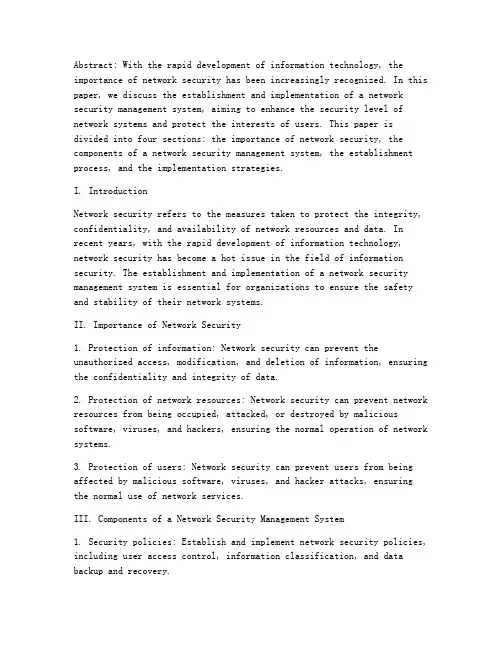
Abstract: With the rapid development of information technology, the importance of network security has been increasingly recognized. In this paper, we discuss the establishment and implementation of a network security management system, aiming to enhance the security level of network systems and protect the interests of users. This paper is divided into four sections: the importance of network security, the components of a network security management system, the establishment process, and the implementation strategies.I. IntroductionNetwork security refers to the measures taken to protect the integrity, confidentiality, and availability of network resources and data. In recent years, with the rapid development of information technology, network security has become a hot issue in the field of information security. The establishment and implementation of a network security management system is essential for organizations to ensure the safety and stability of their network systems.II. Importance of Network Security1. Protection of information: Network security can prevent the unauthorized access, modification, and deletion of information, ensuring the confidentiality and integrity of data.2. Protection of network resources: Network security can prevent network resources from being occupied, attacked, or destroyed by malicious software, viruses, and hackers, ensuring the normal operation of network systems.3. Protection of users: Network security can prevent users from being affected by malicious software, viruses, and hacker attacks, ensuring the normal use of network services.III. Components of a Network Security Management System1. Security policies: Establish and implement network security policies, including user access control, information classification, and data backup and recovery.2. Security technology: Utilize various security technologies, such as firewalls, intrusion detection systems, and encryption algorithms, to protect network resources and data.3. Security management: Establish a network security management organization, define security roles and responsibilities, and implement security training and awareness programs.4. Security monitoring: Set up a network security monitoring system to detect and respond to security incidents in real-time.IV. Establishment Process1. Needs analysis: Identify the network security requirements of the organization, including the protection of information, network resources, and users.2. Policy formulation: Develop network security policies based on the needs analysis, including user access control, informationclassification, and data backup and recovery.3. Technical selection: Choose appropriate security technologies and products to meet the security requirements of the organization.4. Organization establishment: Establish a network security management organization, define security roles and responsibilities, and implement security training and awareness programs.5. Implementation and testing: Implement the network security management system and conduct testing to ensure its effectiveness.V. Implementation Strategies1. Regularly update and optimize security policies and technologies to adapt to the changing security environment.2. Strengthen security monitoring and incident response capabilities, ensuring timely detection and handling of security incidents.3. Conduct regular security training and awareness programs for employees, enhancing their network security awareness and skills.4. Establish a cross-departmental security cooperation mechanism, ensuring effective communication and collaboration in network security management.ConclusionThe establishment and implementation of a network security management system is of great significance for organizations. By following the establishment process and implementing the corresponding strategies, organizations can effectively enhance the security level of their network systems and protect the interests of users.。
计算机病毒原理与防范文章英文文章English:Computer viruses are malicious software programs that can replicate themselves and spread to other computers, causing harm to the system or stealing sensitive data. They can infect computers through various means, such as email attachments, downloads from untrustworthy websites, or removable storage devices. Once a computer is infected, the virus can execute its malicious code, leading to a range of issues, from annoying pop-ups to complete system failure. To prevent computer viruses, users should always keep their operating system and security software up to date, avoid clicking on suspicious links or emails, and refrain from downloading software from unknown sources. Additionally, regularly backing up important data can help minimize the impact of a potential virus attack.中文翻译:计算机病毒是恶意软件程序,可以自我复制并传播到其他计算机,对系统造成危害或窃取敏感数据。
网络信息安全外文翻译文献(文档含英文原文和中文翻译)译文:计算机网络安全浅析摘要:针对计算机网络系统存在的安全性和可靠性问题,本文从网络安全的重要性、理论基础、具备功能以及解决措施等方面提出一些见解,并且进行了详细阐述,以使广大用户在计算机网络方面增强安全防范意识。
关键词:计算机网络虚拟专用网技术加密技术防火墙引言:随着计算机网络技术的发展,网络的安全性和可靠性已成为不同使用层次的用户共同关心的问题。
人们都希望自己的网络系统能够更加可靠地运行,不受外来入侵者干扰和破坏。
所以解决好网络的安全性和可靠性问题,是保证网络正常运行的前提和保障。
一、网络安全的重要性。
在信息化飞速发展的今天,计算机网络得到了广泛应用,但随着网络之间的信息传输量的急剧增长,一些机构和部门在得益于网络加快业务运作的同时,其上网的数据也遭到了不同程度的攻击和破坏。
攻击者可以窃听网络上的信息,窃取用户的口令、数据库的信息;还可以篡改数据库内容,伪造用户身份,否认自己的签名。
更有甚者,攻击者可以删除数据库内容,摧毁网络节点,释放计算机病毒等等。
这致使数据的安全性和自身的利益受到了严重的威胁。
根据美国 FBI(美国联邦调查局)的调查,美国每年因为网络安全造成的经济损失超过170 亿美元。
75的公司报告财政损失是由于计算机系统的安全问题造成的。
超过 50的安全威胁来自内部。
而仅有 59的损失可以定量估算。
在中国,针对银行、证券等金融领域的计算机系统的安全问题所造成的经济损失金额已高达数亿元,针对其他行业的网络安全威胁也时有发生。
由此可见,无论是有意的攻击,还是无意的误操作,都将会给系统带来不可估量的损失。
所以,计算机网络必须有足够强的安全措施。
无论是在局域网还是在广域网中,网络的安全措施应是能全方位地针对各种不同的威胁和脆弱性,这样才能确保网络信息的保密性、完整性和可用性。
二、网络安全的理论基础。
国际标准化组织(ISO)曾建议计算机安全的定义为:“计算机系统要保护其硬件、数据不被偶然或故意地泄露、更改和破坏。
X X X X 学院计算机专业英语班级计科学号12姓名日期2015-12-Security of Computer Network System Abstract: This paper discussed the secure and dependable problem about the computer network system. On some aspects: the importance of network security basic theory function and the method of solving a problem etc. Good views for solving the problem are put forward. It strengthens people’s consciousness on network security.Key words: Computer network Virtual private network Encryption techniques FirewallIntroduction: Along with the computer network technology development the network security and the reliability have become the question of common interest by all users. The people all hoped their own network system can move reliably not external intruder disturbance and destruction .Therefore solves the network security and the reliable problem carefully is a guarantee the network normal operation’s premise and safeguard.First: the importance of the network security. With the information developing fast today the computer network obtained the widespread application but along with the network information transmission capacity growing faster some organizations and departments benefit the speed up with the service operation in the network while the data has also suffered to extent attack and destruction. The aggressor may intercept the information in the network steals the user’s password the database information also may tamper with the database content the forge users status denies own signature. And what is more the aggressor may delete the database content the destroy node releases computer virus and so on. This cause data security and own benefit have received the serious threat. According to American FBI US Federal Bureau of Investigation invest the network security creates the economic loss surpasses 17 billion dollars every year.75 corporation report finance loss is because the computer system security problem creates. More than 50 safe threat come from inside. But only 59 loss could be possible estimate. In China the economic loss amount in view of financial domain and the banknegotiable securities computer system security problems creates has reached as high as several hundred million Yuan also sometimes occurs in view of other profession network security threat. Thus it can be seen regardless of is the mean attack or unconscious disoperation will all be able to bring the inestimable loss to the system. Therefore the computer network must have the enough strong security measure. Regardless of is in the local area network or in WAN the network security measure should be Omni-directional in view of each kind of different threat and the vulnerability so that it can guarantee the network information’s secrecy the integrity and the usability.Second: Network security rationale. International Standardization Organization ISO once suggested the computer security the definition was: “The computer system must protect its hardware the data not accidentally or reveals intentionally the change and the destruction.”In order to help the computer user discrimination and the solution computer network security problem the American Department of Defense announced “the orange peel book”orange book official name is “credible computer system standard appraisal criterion”has carried on the stipulation to the multiuser computer system security rank division. The orange peel book from low to high divides into the computer security four kinds of seven levels: D1 C1 C2 B1 B2 B3 A1.Above allD1 level does not have the lowest safety margin rank C1 and the C2 level has the lowest safety margin rank B1 and the B2 level has the medium safekeeping of security ability rank B3 and A1 belongs to the highest security rating. In the network concrete design process it should act according to each technology standard the equipment type the performance requirement as well as the funds which in the network overall plan proposed and so on the overall evaluation determines one quite reasonably the performance high network security rank thus realization network security and reliability.Third: The network security should have function. In order to adapt the information technology development well the computer network application system must have following function: 1 Access control: Through to the specificwebpage the service establishment access control system in arrives the overwhelming majority attack impediment in front of the attack goal. 2 Inspects the security loophole: Through to security loophole cyclical inspection even if attacks may get the attack goal also may cause the overwhelming majority attack to be invalid. 3 Attack monitoring: Through to specific webpage service establishment attack monitoring system but real-time examines the overwhelming majority attack and adopts the response the motion for example separation network connection recording attack process pursuit attack source and so on. 4 Encryption Communication: Encrypts on own initiative the communication may enable the aggressor to understand the revision sensitive information. 5 Authentication: The good authentication system may prevent the aggressor pretends the validated user. 6 Backup and restoration: The good backup and restores the mechanism may causes the losses when the attack as soon as possible restores the data and the system service. 7 Multi-layered Defense: The aggressor after breaks through the first defense line delays or blocks it to reach the attack goal. 8 Sets up the safe monitoring center: Provides the security system management the monitoring the protection and the emergency case service for the information system.Fourth: The network system safety comprehensive solution measures. If want to realize the network security function we should carry on the Omni-directional guarding to the network system and thus formulate the quite reasonable network security architecture. Below on the network system security problem proposes some guard measure. Physics safe may divide into two aspects: One is the artificial harm to the network the other is the network to the users. Most common thing is the constructor who did not understand to the buried cable clearly thus lead to the destruction of electric cable this kind of situation may through standing symbolized the sign guards against Has not used the structure wiring the network to be able to appear the user frequently to the electric cable damage this needs to use the structure wiring to install the network as far as possible Artificial or naturaldisaster influence when to consider the plan. The access control security the access control distinguishes and confirms the user limits the user in the already activity and the resources scope which is authorized. The network access control safe may consider from following several aspects. 1 password: The network security system most outer layer defense line is network users registering in the registration process the system would inspect the user to register the name and the password validity only then the legitimate user can enter the system. 2 The network resources’host the attribute and the visit jurisdiction: The network resources mainly include the resources which shared files the shared printer network users and so on that all the network users can use. The resources were the host to manifest the different user to the resources subordinate relations such as builder modifier and group member and so on. The resources attribute expressed itself deposit and withdrawal characteristics as can read by who write or the execution and so on. The visit jurisdiction mainly manifests in the user to the network resources available degree in using assigns the network resources to be the host the attribute and the visit jurisdiction may effectively in the application cascade control network system security. 3 Network security surveillance: The network surveillance is generally called for “the network management”its function mainly is carries on the dynamic surveillance to the entire network movement and handles each kind of event promptly. May understand simply through the network surveillance discovers and solves in the network security problem such as the localization network fault point seizes the IP embezzler the control network visit scope and so on. 4 Audit and track: Network audit and track which is including the network aspect resources use network breakdown and system keeping. It composed generally by two parts: One the recording event soon each kind of event entirely records in the document. Two carries on the analysis and the statistics to. Data transmission security, transmission security requirements to protect the information on the network is transmitted to prevent the passive and active violations. The security of data transmission can take the following measures: (1)encryption and digital signature: digital signature is the receiver of data used to confirm the sender of the data is true and correct. (2) firewall: firewall (Firewall) is a security measure that is widely used in Internet. It can be used to set up a series of components in different network or network security domain. It can detect, limit and change the data flow of the firewall, and detect the information, structure and running status of the network as far as possible, so as to realize the network security. (3) Username or Password certification: the authentication method is the most commonly used as an authentication method for the operating system, telnet (remote login), rlogin (remote login), but the process is not encrypted, that is, password is easy to be monitored and decryption. (4) authentication using the algorithm: radius (Remote Authentication Dial protocol, OSPF (open routing protocol), SNMP Security Protocol use shared Security Key (key), and the abstract algorithm (MD5) certification, but abstract algorithm is an irreversible process, therefore, in the authentication process, by the information cannot be calculated Security Key shared, so the sensitive information in the network transmission. The algorithm is mainly used on the market are mainly MD5 and SHA - 1. (5) authentication and encryption based on PKI: using PKI (public key system). This method has a high security level, which is integrated with the technology of the algorithm, asymmetric encryption, symmetric encryption, digital signature, and so on. This authentication method is currently used in the fields of email, application server access, customer authentication, firewall authentication, etc.. This kind of authentication method is very safe, but it involves a relatively heavy certificate management task. (6) virtual private network (VPN) technology: VPN technology mainly provides two-way communication in the public security, the transparent encryption scheme to ensure data integrity and confidentiality.In summary, for the security of computer network transmission, we must do the following. First, we should strictly limit access to the Internet users of the system information and resources, this function can be achieved by setting the Net Screen firewall on the access server. Second, we should strengthen the identityauthentication of Internet users, using RADIUS and other special authentication server. On the one hand, it can achieve the unified management of Internet users account; on the other hand, in the process of identity verification using encryption means to avoid the possibility of leakage of the account. Third: The use of encryption technology in the process of data transmission, to prevent data theft. One way is to use for Business Security PGP to encrypt data. Another approach is to use the VPN technology provided by Net Screen firewall. VPN in the provision of network data encryption, but also provides a single user of the encryption software, that is, the use of software encryption technology to ensure the security of data transmission.浅析计算机网络安全摘要:针对计算机网络系统存在的安全性和可靠性问题,本文从网络安全的重要性、理论基础、具备功能以及解决措施等方面提出一些见解,并且进行了详细的阐述,以使广大用户在计算机网络方面提高安全防范意识。
网络安全参考文献网络安全是当今社会中一个非常重要的领域,以下是几篇关于网络安全的参考文献:1. Meyerovich, L. A., & Livshits, B. (2010). Cuts: Static enforcement of security policies for web applications. ACM SIGPLAN Notices, 45(6), 23-32.这篇论文介绍了一个静态分析工具Cuts,它可以用于在Web 应用程序中强制执行安全策略,从而提高网络安全性。
2. McFadden, T., & McGrath, M. (2013). Cybersecurity: Public sector threats and responses. Cambridge Journal of Regions, Economy and Society, 6(1), 33-48.该研究探讨了公共部门面临的网络安全威胁和应对措施,包括政策制定和安全培训等方面。
3. Liu, C. N., & Chiang, C. C. (2016). A survey of recent advances in intrusion detection systems. Computers & Electrical Engineering, 54, 266-282.此文综述了入侵检测系统的最新进展,包括基于网络流量、机器学习和数据挖掘等技术的应用。
4. Kirda, E., Kruegel, C., & Vigna, G. (2019). An introduction to malware analysis. IEEE Security & Privacy, 17(5), 32-37.这篇文章介绍了恶意软件分析的基本概念和方法,特别关注了静态和动态分析技术。
计算机安全漏洞中英文对照外文翻译文献(文档含英文原文和中文翻译)Talking about security loopholesreference to the core network security business objective is to protect the sustainability of the system and data security, This two of the main threats come from the worm outbreaks, hacking attacks, denial of service attacks, Trojan horse. Worms, hacker attacks problems and loopholes closely linked to, if there is major security loopholes have emerged, the entire Internet will be faced with a major challenge. While traditional Trojan and little security loopholes, but recently many Trojan are clever use of the IE loophole let you browse the website at unknowingly were on the move.Security loopholes in the definition of a lot, I have here is a popular saying: can be used to stem the "thought" can not do, and are safety-related deficiencies. Thisshortcoming can be a matter of design, code realization of the problem.Different perspective of security loo phole sIn the classification of a specific procedure is safe from the many loopholes in classification.1. Classification from the user groups:● Public loopholes in the software category. If the loopholes in Windows, IEloophole, and so on.● specialized software loophole. If Oracl e loopholes, Apache, etc. loopholes.2. Data from the perspective include :● could not reasonably be read and read data, including the memory of thedata, documents the data, Users input data, the data in the database, network,data transmission and so on.● designated can be written into the designated places (including the localpaper, memory, databases, etc.)● Input data can be implemented (including native implementation,according to Shell code execution, by SQL code execution, etc.)3. From the point of view of the scope of the role are :● Remote loopholes, an attacker could use the network and directly throughthe loopholes in the attack. Such loopholes great harm, an attacker can createa loophole through other people's computers operate. Such loopholes and caneasily lead to worm attacks on Windows.● Local loopholes, the attacker must have the machine premise accesspermissions can be launched to attack the loopholes. Typical of the localauthority to upgrade loopholes, loopholes in the Unix system are widespread,allow ordinary users to access the highest administrator privileges.4. Trigger conditions from the point of view can be divided into:● Initiative trigger loopholes, an attacker can take the initiative to use theloopholes in the attack, If direct access to computers.● Passive trigger loopholes must be computer operators can be carried outattacks with the use of the loophole. For example, the attacker made to a mailadministrator, with a special jpg image files, if the administrator to open image files will lead to a picture of the software loophole was triggered, thereby system attacks, but if managers do not look at the pictures will not be affected by attacks.5. On an operational perspective can be divided into:● File operation type, mainly for the operation of the target file path can be controlled (e.g., parameters, configuration files, environment variables, the symbolic link HEC), this may lead to the following two questions: ◇Content can be written into control, the contents of the documents can be forged. Upgrading or authority to directly alter the important data (such as revising the deposit and lending data), this has many loopholes. If history Oracle TNS LOG document can be designated loopholes, could lead to any person may control the operation of the Oracle computer services;◇information content can be output Print content has been contained to a screen to record readable log files can be generated by the core users reading papers, Such loopholes in the history of the Unix system crontab subsystem seen many times, ordinary users can read the shadow of protected documents;● Memory coverage, mainly for memory modules can be specified, write content may designate such persons will be able to attack to enforce the code (buffer overflow, format string loopholes, PTrace loopholes, Windows 2000 history of the hardware debugging registers users can write loopholes), or directly alter the memory of secrets data.● logic errors, such wide gaps exist, but very few changes, so it is difficult to discern, can be broken down as follows : ◇loopholes competitive conditions (usually for the design, typical of Ptrace loopholes, The existence of widespread document timing of competition) ◇wrong tactic, usually in design. If the history of the FreeBSD Smart IO loopholes. ◇Algorithm (usually code or design to achieve), If the history of Microsoft Windows 95/98 sharing passwordcan easily access loopholes. ◇Imperfections of the design, such as TCP / IP protocol of the three-step handshake SYN FLOOD led to a denial of service attack. ◇realize the mistakes (usually no problem for the design, but the presence of coding logic wrong, If history betting system pseudo-random algorithm)● External orders, Typical of external commands can be controlled (via thePATH variable, SHELL importation of special characters, etc.) and SQL injection issues.6. From time series can be divided into:● has long found loopholes: manufacturers already issued a patch or repairmethods many people know already. Such loopholes are usually a lot of people have had to repair macro perspective harm rather small.● recently discovered loophole: manufacturers just made patch or repairmethods, the people still do not know more. Compared to greater danger loopholes, if the worm appeared fool or the use of procedures, so will result in a large number of systems have been attacked.● 0day: not open the loophole in the private transactions. Usually such loopholesto the public will not have any impact, but it will allow an attacker to the target by aiming precision attacks, harm is very great.Different perspective on the use of the loopholesIf a defect should not be used to stem the "original" can not do what the (safety-related), one would not be called security vulnerability, security loopholes and gaps inevitably closely linked to use.Perspective use of the loopholes is:● Data Perspective: visit had not visited the data, including reading and writing.This is usually an attacker's core purpose, but can cause very serious disaster (such as banking data can be written).● Competence Perspective: Major Powers to bypass or permissions. Permissionsare usually in order to obtain the desired data manipulation capabilities.● Usability p erspective: access to certain services on the system of controlauthority, this may lead to some important services to stop attacks and lead to a denial of service attack.● Authentication bypass: usually use certification system and the loopholes willnot authorize to access. Authentication is usually bypassed for permissions or direct data access services.● Code execution perspective: mainly procedures for the importation of thecontents as to implement the code, obtain remote system access permissions or local system of higher authority. This angle is SQL injection, memory type games pointer loopholes (buffer overflow, format string, Plastic overflow etc.), the main driving. This angle is usually bypassing the authentication system, permissions, and data preparation for the reading.Loopholes explore methods mustFirst remove security vulnerabilities in software BUG in a subset, all software testing tools have security loopholes to explore practical. Now that the "hackers" used to explore the various loopholes that there are means available to the model are:● fuzz testing (black box testing), by constructing procedures may lead toproblems of structural input data for automatic testing.● FOSS audit (White Box), now have a series of tools that can assist in thedetection of the safety procedures BUG. The most simple is your hands the latest version of the C language compiler.● IDA anti-compilation of the audit (gray box testing), and above the sourceaudit are very similar. The only difference is that many times you can obtain software, but you can not get to the source code audit, But IDA is a very powerful anti-Series platform, let you based on the code (the source code is in fact equivalent) conducted a safety audit.● dynamic tracking, is the record of proceedings under different conditions andthe implementation of all security issues related to the operation (such as file operations), then sequence analysis of these operations if there are problems, it is competitive category loopholes found one of the major ways. Other tracking tainted spread also belongs to this category.● patch, the software manufacturers out of the question usually addressed in thepatch. By comparing the patch before and after the source document (or the anti-coding) to be aware of the specific details of loopholes.More tools with which both relate to a crucial point: Artificial need to find a comprehensive analysis of the flow path coverage. Analysis methods varied analysis and design documents, source code analysis, analysis of the anti-code compilation, dynamic debugging procedures.Grading loopholesloopholes in the inspection harm should close the loopholes and the use of the hazards related Often people are not aware of all the Buffer Overflow Vulnerability loopholes are high-risk. A long-distance loophole example and better delineation:●Remote access can be an OS, application procedures, version information.●open unnecessary or dangerous in the service, remote access to sensitiveinformation systems.● Remote can be restricted for the documents, data reading.●remotely important or restricted documents, data reading.● may be limited for long-range document, data revisions.● Remote can be restricted for important documents, data changes.● Remote c an be conducted without limitation in the important documents, datachanges, or for general service denial of service attacks.● Remotely as a normal user or executing orders for system and network-leveldenial of service attacks.● may be remote managem ent of user identities to the enforcement of the order(limited, it is not easy to use).● can be remote management of user identities to the enforcement of the order(not restricted, accessible).Almost all local loopholes lead to code execution, classified above the 10 points system for:●initiative remote trigger code execution (such as IE loophole).● passive trigger remote code execution (such as Word gaps / charting softwareloopholes).DEMOa firewall segregation (peacekeeping operation only allows the Department of visits) networks were operating a Unix server; operating systems only root users and users may oracle landing operating system running Apache (nobody authority), Oracle (oracle user rights) services.An attacker's purpose is to amend the Oracle database table billing data. Its possible attacks steps:● 1. Access peacekeeping operation of the network. Access to a peacekeepingoperation of the IP address in order to visit through the firewall to protect the UNIX server.● 2. Apache s ervices using a Remote Buffer Overflow Vulnerability direct accessto a nobody's competence hell visit.● 3. Using a certain operating system suid procedure of the loophole to upgradetheir competence to root privileges.● 4. Oracle sysdba landing into t he database (local landing without a password).● 5. Revised target table data.Over five down for process analysis:●Step 1: Authentication bypass●Step 2: Remote loopholes code execution (native), Authentication bypassing● Step 3: permissions, auth entication bypass● Step 4: Authentication bypass● Step 5: write data安全漏洞杂谈网络安全的核心目标是保障业务系统的可持续性和数据的安全性,而这两点的主要威胁来自于蠕虫的暴发、黑客的攻击、拒绝服务攻击、木马。
Web 应用程序安全外文文献翻译(含:英文原文及中文译文)英文原文Basic Security Practices for Web ApplicationsEven if you have limited experience with and knowledge of application security, there are basic measures that you should take to help protect your Web applications. The following sections in this topic provide minimum-security guidelines that apply to all Web applications. General Web Application Security Recommendations; Run Applications with Minimum Privileges; Know Y our Users; Guard against Malicious User Input; Access Databases Securely; Create Safe Error Messages; Keep Sensitive Information Safely; Use Cookies Securely; Guard Against Denial-of-Service Threats.1. General Web Application Security RecommendationsEven the most elaborate application security can fail if a malicious user can use simple ways to gain access to your computers. General Web application security recommendations include the following: Back up data often and keep your backups physically secure. Keep your Web server physically secure so that unauthorized users cannot gain access to it, turn it off, and physically steal it, and so on. Use the Windows NTFS file system, not FA T32. NTFS offers substantially more security thanFA T32. Protect the Web server and all of the computers on the same network with strong passwords. Follow best practices for securing Internet Information Services (IIS). Close any unused ports and turn off unused services. Run a virus checker that monitors site traffic. Use a firewall. Learn about and install the latest security updates from Microsoft and other vendors. Use Windows event logging and examine the logs frequently for suspicious activity. This includes repeated attempts to log on to your system and excessive requests against your Web server.2. Run Applications with Minimum PrivilegesWhen your application runs, it runs within a context that has specific privileges on the local computer and potentially on remote computers. For information about configuring application identity, see Configuring Process Identity. To run with the minimum number of privileges needed, follow these guidelines: Do not run your application with the identity of a system user (administrator).Run the application in the context of a user with the minimum practical privileges. Set permissions (ACL’s, or Access Control Lists) on all the resources required for your application. Use the most restrictive setting. For example, if practical in your application, set files to be read-only. For a list of the minimum ACL permissions required for the identity of your application, see Required Access Control Lists (ACL’s).Keep files for your Web application in a folder below theapplication root. Do not allow users the option of specifying a path for any file access in your application. This helps prevent users from getting access to the root of your server.3. Know Y our UsersIn many applications, it is possible for users to access the site without having to provide credentials. If so, your application accesses resources by running in the context of a predefined user. By default, this context is the local ASPNET user (Windows 2000 or Windows XP) or NETWORK SERVICE user (Windows Server 2003) on the Web server. To restrict access to users who are authenticated, follow these guidelines: If your application is an intranet application, configure it to use Windows Integrated security. This way, the user's login credentials can be used to access resources. If you need to gather credentials from the user, use one of the authentication strategies. For an example, see the Forms Authentication Overview.4. Guard against Malicious User InputAs a general rule, never assume that input you get from users is safe. It is easy for malicious users to send potentially dangerous information from the client to your application. To help guard against malicious input, follow these guidelines: In forms, filter user input to check for HTML tags, which might contain script. For details, see How to: Protect Against Script Exploits in a Web Application by Applying HTML Encoding toStrings. Never echo (display) unfiltered user input. Before displaying entrusted information, encode HTML to turn potentially harmful script into display strings. Similarly, never store unfiltered user input in a database. If you want to accept some HTML from a user, filter it manually. In your filter, explicitly define what you will accept. Do not create a filter that tries to filter out malicious input; it is very difficult to anticipate all possible malicious input. Do not assume that information you get from the header (usually via the Request object) is safe. Use safeguards for query strings, cookies, and so on. Be aware that information that the browser reports to the server (user agent information) can be spoofed, in case that is important in your application. If possible, do not store sensitive information in a place that is accessible from the browser, such as hidden fields or cookies.5. Access Databases SecurelyDatabases typically have their own security. An important aspect Web application security is designing a way for the application to access the database securely. Follow these guidelines: Use the inherent security of your database to limit who can access database resources. The exact strategy depends on your database and your application:If practical in your application, use Windows Integrated security so that only Windows-authenticated users can access the database. Integrated security is more secure than using SQL Server standard security. If yourapplication uses anonymous access, create a single user with very limited permissions, and perform queries by connecting as this user. Do not create SQL statements by concatenating strings that involve user input. Instead, create a parameterized query and use user input to set parameter values. If you must store a user name and password somewhere to use as the database login credential, store them securely. If practical, encrypt or hash them. For details, see Encrypting and Decrypting Data.6. Create Safe Error MessagesIf you are not careful, a malicious user can deduce important information about your application from the error messages it displays. Follow these guidelines: Do not write error messages that echo information that might be useful to malicious users, such as a user name. Configure the application not to show detailed errors to users. If you want to display detailed error messages for debugging, check first that the user is local to the Web server. For details, see How to: Display Safe Error Messages. Use the custom Errors configuration element to control who can view exceptions from the server. Create custom error handling for situations that are prone to error, such as database access.7. Keep Sensitive Information SafelySensitive information is any information that you need to keep private. A typical piece of sensitive information is a password or an encryption key. If a malicious user can get to the sensitive information,then the data protected by the secret is compromised. Follow these guidelines: If your application transmits sensitive information between the browser and the server, consider using Secure Sockets Layer (SSL). Use Protected Configuration to secure sensitive information in configuration files such as the Web. config or Machine. config files. For more information, see Encrypting Configuration Information Using Protected Configuration. If you must store sensitive information, do not keep it in a Web page, even in a form that you think people will not be able to view (such as in server code).Use the strong encryption algorithms supplied in the System Security Cryptography namespace.8 . Use Cookies SecurelyCookies are an easy and useful way to keep user-specific information available. However, because cookies are sent to the browser's computer, they are vulnerable to spoofing or other malicious use. Follow these guidelines: Do not store any critical information in cookies. For example, do not store a user's password in a cookie, even temporarily. As a rule, do not store any sensitive information in a cookie that. Instead, keep a reference in the cookie to a location on the server where the information is located. Set expiration dates on cookies to the shortest practical time you can. Avoid permanent cookies if possible. Consider encrypting information in cookies. Consider setting the Secure and Http Only properties on your cookies to true.9. Guard against Denial-of-Service ThreatsAn indirect way that a malicious user can compromise your application is by making it unavailable. The malicious user can keep the application too busy to service other users, or if nothing else can simply crash the application. Follow these guidelines: Close or release any resource you use. For example, always close data connections and data readers, and always close files when you are done using them. Use error handling (for example, try/catch blocks). Include a finally block in which you release resources in case of failure. Configure IIS to use throttling, which prevents an application from using a disproportionate amount of CPU. Test size limits of user input before using or storing it. Put size safeguards on database queries to help guard against large queries using up system resources. Y ou can also use the Request Length Disk Threshold property in to reduce the memory overhead of large uploads and form posts.中文译文Web 应用程序的基本安全做法即使您对应用程序安全性的体验和了解非常有限, 也应采取一些基本措施来保护您的Web 应用程序。
计算机网络安全与防范外文翻译文献 1 计算机网络安全与防范外文翻译文献
(文档含中英文对照即英文原文和中文翻译) 翻译: 计算机网络安全与防范 1.1引言 计算机技术的飞速发展提供了一定的技术保障,这意味着计算机应用已经渗透到社会的各个领域。在同一时间,巨大的进步和网络技术的普及,社会带来了巨大的经济利润。然而,在破坏和攻击计算机信息系统的方法已经改变了很多的网络环境下,网络安全问题逐渐成为计算机安全的主流。 计算机网络安全与防范外文翻译文献
2 1.2网络安全
1.2.1计算机网络安全的概念和特点 计算机网络的安全性被认为是一个综合性的课题,由不同的人,包括计算机科学、网络技术、通讯技术、信息安全技术、应用数学、信息理论组成。作为一个系统性的概念,网络的安全性由物理安全、软件安全、信息安全和流通安全组成。从本质上讲,网络安全是指互联网信息安全。一般来说,安全性、集成性、可用性、可控性是关系到网络信息的相关理论和技术,属于计算机网络安全的研究领域。相反,狭隘“网络信息安全”是指网络安全,这是指保护信息秘密和集成,使用窃听、伪装、欺骗和篡夺系统的安全性漏洞等手段,避免非法活动的相关信息的安全性。总之,我们可以保护用户利益和验证用户的隐私。 计算机网络安全有保密性、完整性、真实性、可靠性、可用性、非抵赖性和可控性的特点。 隐私是指网络信息不会被泄露给非授权用户、实体或程序,但是授权的用户除外,例如,电子邮件仅仅是由收件人打开,其他任何人都不允许私自这样做。隐私通过网络信息传输时,需要得到安全保证。积极的解决方案可能会加密管理信息。虽然可以拦截,但它只是没有任何重要意义的乱码。 完整性是指网络信息可以保持不被修改、破坏,并在存储和传输过程中丢失。诚信保证网络的真实性,这意味着如果信息是由第三方或未经授权的人检查,内容仍然是真实的和没有被改变的。因此保持完整性是信息安全的基本要求。 可靠性信息的真实性主要是确认信息所有者和发件人的身份。 可靠性表明该系统能够在规定的时间和条件下完成相关的功能。这是所有的网络信息系统的建立和运作的基本目标。 可用性表明网络信息可被授权实体访问,并根据自己的需求使用。 不可抵赖性要求所有参加者不能否认或推翻成品的操作和在信息传输过程中的承诺。计算机网络安全与防范外文翻译文献 3 处理不可抵赖性的措施之一是使用数字签名技术。 可控性指示控制网络信息传输和内容的能力上。例如,禁止违法和不良信息通过公共网络传输。
1.3计算机网络所面临的威胁 计算机网络所面临的各种威胁有:恶意攻击,泄漏软件,计算机病毒和自然灾害。 1.3.1恶意攻击 恶意攻击被认为是计算机网络的严重威胁之一。根据建议可以将人为破坏分为主动攻击和被动攻击。主动攻击旨在破坏网络和信息,通常使用的方式有修改、删除、弄虚作假、欺骗、病毒和逻辑炸弹。一旦成功,它可能会停止网络系统的运行,甚至整个系统的瘫痪。被动攻击是为了获取信息,这通常是进行窃取秘密信息,我们知道的,如在不影响正常运行的情况下进行的窃取贸易和商业秘密、项目计划、投标数字和个人信息。恶意攻击,不管是模仿或者被动,都可能会损坏严重的电脑网络,导致机密数据的泄漏,最终造成不可挽回的损失。
1.3.2软件的泄漏和后门(计算) 有两种软件泄漏:一种是通过建议精心设计来控制系统和窃取信息为将来使用所准备,另一种是意外,比如因为设计师的疏忽或其他技术元素。然而,由于这些漏洞的存在导致了严重的隐藏的网络安全威胁。例如,为了方便地进入操作系统开发者没有为系统设置进入密码,这将为黑客提供进入系统的通道。进行作业系统时,一些系统进程一直在等待某些条件,一旦一次满意的条件下出现,这一进程将继续运行,这也可以被黑客利用。否则,虽然一直保持保密,由程序员设置了供自己使用的一些后门程序(计算),如果它们泄露出去,或由其他人发现这可能会带来巨大的损害和信息丢失。 计算机网络安全与防范外文翻译文献 4 1.3.3计算机病毒破坏网络安全
计算机病毒是一个专门的计算机程序,它通过各种渠道比如磁盘,光盘和计算机网络进行复制和传播。它在20世纪80年代首先发现,到现在的数字已经提高到世界各地的10,000多个。同时,隐瞒、传染和破坏也进一步发展。随着互联网的飞速发展,计算机病毒的扩散速度已经在很大程度上加快,大大破坏和传染世界各地资源。这场灾难对每一个国家和整个世界的信息系统产生了一个严重的影响。美国大约63%的计算机被传染了病毒, 9%的情况下已经导致了超过10万美元的损失,根据著名的MIS系统管理和数据任务营销公司进行的研究。在1996年,计算机病毒已经造成美国制造业大1亿美元的经济损失。互联网提供了计算机病毒容易扩散的环境,同时增加了消灭他们的困难。计算机病毒的传播,不仅破坏网络,也使网络信息泄漏。计算机病毒已经严重威胁到网络安全,特别是专用网络。 病毒代码很小,通常附在其他文件或程序末尾,因此它们很容易隐藏在系统内部。病毒的自我复制能力使其在网络上传播时能够传染给其他文件和程序,病毒一旦扩散到网络上就非常难以追踪了。 1987年,计算机病毒在美国四处蔓延,而且第一种计算机病毒“小球”在当年年底传播到我国。从那以后,已经发现进口和国内的病毒。迄今为止,计算机病毒已经增加到20,000多种;其中90%以上能攻击微型计算机。病毒的基本特征有:
(1) 传染:计算机病毒作为一个程序,能自我复制到其他正常程序或者系统的某些部件上,例如磁盘的引导部分。这是病毒程序的基本特征。随着网络日益广泛发展,计算机病毒能够在短时间内通过网络广泛传播。 (2) 潜伏:隐藏在受感染系统内的病毒并不立即发作;相反,在它发作前,需要一定时间或具备某些条件。在潜伏期内,它并不表现出任何扰乱行动,因此很难发现病毒并且病毒能够继续传播。一旦病毒发作,它能造成严重破坏。 计算机网络安全与防范外文翻译文献 5 (3) 可触发性:一旦具备某些条件,病毒便开始攻击。这一特征称作可触发性。利用这一特征,我们能控制其传染范围和攻击频率。触发病毒的条件可能是预设的日期、时间、文件种类或计算机启动次数等。 (4) 破坏:计算机病毒造成的破坏是广泛的—它不仅破坏计算机系统、删除文件、更改数据等,而且还能占用系统资源、扰乱机器运行等。其破坏表现出设计者的企图。
通过我们已经学过的知识,我们知道病毒有如下的分类: (1) 按寄生分类 按寄生,计算机病毒可分成引导病毒、文件病毒和混合病毒。*引导病毒:指寄生在磁盘引导部分的那些计算机病毒。它是一种常见病毒,利用计算机系统通常不检查引导部分的内容是否正确的弱点,并且留存在内存中,监视系统运行,一有机会就传染和破坏。按寄生在磁盘的位置,它能进一步分成主引导记录病毒和段引导记录病毒。前者传染硬盘的主引导部分,例如“marijuana”病毒、“2708”病毒、“porch”病毒;段记录病毒传染硬盘上的常用段记录,例如“小球”病毒、“女孩”病毒等。
(2) 按后果分类 从后果看,计算机病毒能分成“良性”病毒和“恶性”病毒。“良性”病毒将破坏数据或程序,但不会使计算机系统瘫痪。这种病毒的始作俑者大多是胡闹的黑客—他们创造病毒不是为了破坏系统,而是为了炫耀他们的技术能力;一些黑客使用这些病毒传播他们的政治思想和主张,例如“小球”病毒和“救护车”病毒。“恶性”病毒将破坏数据和系统,导致整个计算机瘫痪,例如CHI病毒,“Porch”病毒。这些病毒一旦发作,后果将是无法弥补的。 计算机网络安全与防范外文翻译文献
6 应当指出,“危险”是计算机病毒的共同特征。“良性”病毒并非完全不造成危险,而只是危险后果相对较轻。“良性”只是一个相对概念。事实上,所有计算机病毒都是恶性的。
1.4计算机网络安全防范措施 为了保护网络资源,我们应该指导一些管理和合理的说明。此外,我们必须进行有关的技术措施,旨在解决网络安全中存在的问题,实现网络和数据的保护。在此之后,可以保证定期循环,可以确保合法用户的利益。目前,处理网络安全的措施如下:防火墙技术,加密技术,访问控制技术和病毒防护技术。
1.4.1防火墙技术 在目前保护计算机网络安全的技术措施中,防火墙可以分割本地网络和主网络,在保护网络和外部网络之间限制信息访问和传输。 防火墙是关闭在网络拓扑结构和服务上不安全因素来提高网络的工具。它保护的对象之一就是明确在网络接近临界点的模块,而它远离是外部威胁来保护网络。因此,在公司它首先是适合在专门的网络,尤其是连接公共网络。防火墙三个的基本功能如下: 过滤。它可以拒绝未经授权的电脑主机发送TCP / IP协议数据,并拒绝接受未经授权的服务链接要求。 网络地址转换。翻译内部主机的IP地址以避免通过外部监视器被检测,或者我们可以说成IP伪装。 代理服务。代表主机电脑应用方面具有较高水平,能够完全中断连接之间的跨主机和外部网络层。 我们应该更加注重的是没有防火墙可以提供绝对的保护。防火墙具有边界,其中包括来自防火墙外部其他攻击方式的无用保护;难以阻止病毒污染的软件或文件的传输,几乎没有拒绝构成内部用户的威胁;几乎可以防止运行数据的攻击。此外,由于防火墙的安全计算机网络安全与防范外文翻译文献 7 政策在公司是由网络管理员来控制的,所以他的道德标准似乎更为重要。
1.4.2 加密技术 加密的目的是为了保护数据、文件、密码和网络上的控制信息,以及保护网络上数据传输。这个过程实际上是进行了各种加密算法,用最低的成本获得一些保护。在大多数情况下,加密是保证信息保密性和重要性的唯一途径。加密系统可以根据分类代码之间信息的发送者和接受密码的方式,通常被划分成对称加密代码(单个键)和公共加密代码(双击键),如典型的代表DES和RSA。 伴随着高加密产生的优势之一是对称加密代码管理与安全方式传输信息的难度。公众的加密代码的优势是它可以适用于网络不限成员名额的要求,并实现数字签名和验证。然而,复杂的算法将使数据加密速度放缓。随着现代电子技术和加密技术的发展,公共密码编码算法将逐渐成为网络安全加密系统的主流。人们通常将常规密码和公共密码在网络安全中一起同应用。 常规的网络数据加密具有链路、节点和端到端的方式。作为最常用的加密方式,链路加密可以通过链路层和物理层在网络和硬件条件下实现。它用来保护通信节点传输的数据,对用户是透明的。节点加密提高了链路加密和克服链路加密很容易被非法访问的缺陷。它也可以在协议传输层加密,使原始节点和目的节点之间传输的数据进行加密保护。端到端的加密是在网络层,在表示层中的网络和数据传输加密具有高水平的水准,而不是低级别的协议信息。相比链路加密它往往是由软件完成,它具有较低的成本和更高的安全性。